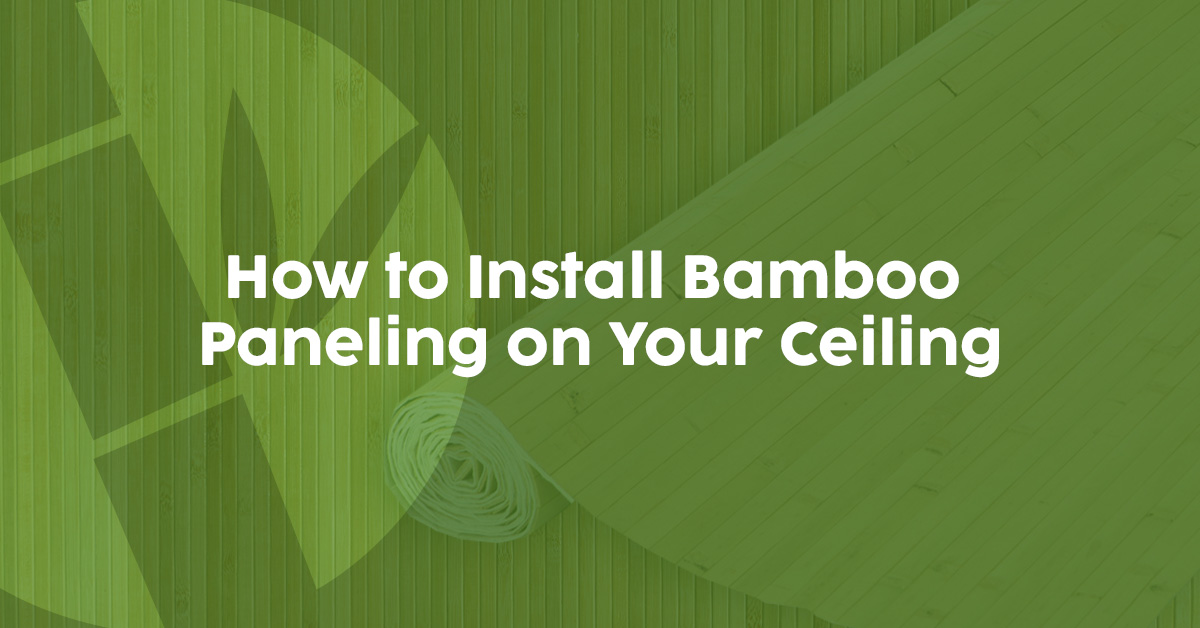Bamboo is a highly versatile material that can add a wonderful tropical aesthetic to any space. It is also one of the most eco-friendly materials, as it adds oxygen to the air and doesn’t require fertilizers, chemicals or pesticides.
Whether you are a DIYer, homeowner or business owner looking to decorate your space, learn how to install bamboo paneling and take care of your new ceiling.
Gathering the Materials and Tools
Before you begin your DIY bamboo ceiling installation, you must gather a few items, including the type of bamboo paneling you want and the tools to install it.
Bamboo Paneling
Bamboo ceiling panels offer a wonderful tropical touch to any interior space. Because the material is flexible, it can also bend and adjust to accommodate ceilings with concave and convex elements. There are several styles to choose from, including the following:
- Natural
- Carbonized
- Tortoise
- Dark chocolate
- Raw green
- Burnt raw green
- Natural raw
- Natural burnt
Tools
In addition to the paneling, you will need the following for your installation:
- Ladder
- Measuring tape
- Telescopic duster
- Marker or pencil
- Fine-toothed chop saw blade
- Razor blade or sharp scissors
- Glue
- Plywood (optional, depending on the ceiling type)
- Industrial staple gun, nail gun or hammer
- Stainless steel staples or nails
- Bamboo sealer
- Bamboo slats
Preparing the Space
Here’s how to prep before the installation.
1. Clear the Area
Ensure the work area is tidy and free of obstacles. Remove fixtures that could interfere with your installation, such as ceiling fans or large lighting fixtures.
2. Measure the Ceiling
Use your measuring tape to measure your ceiling and calculate its square footage. This will help you determine how many rolls of bamboo paneling you will need. Most rolls are 4 feet by 8 feet and have a thickness of 1/8 inch.
3. Choose Paneling
Select paneling from a reputable company dedicated to sustainability. Consider the rest of your decor elements, including your walls, flooring and furnishings, to decide which style suits your home or business space. To complete the look, choose a trim for the edges of the paneling. Bamboo slats are an excellent option due to their strength and aesthetics.
4. Clean the Ceiling
Before applying your bamboo paneling, make sure the surface is as smooth as possible and structurally sound. Remove dust with a telescopic duster, address mildew and remove flaking paint to ensure an even and clean surface.
Planning the Layout

One essential aspect of creating the ideal tropical-style ceiling is planning the layout.
1. Design Ideas
Bamboo paneling is one of the most stylish and unique ceiling decor ideas because you can cut it to customize its layout. Here are some layout ideas:
- Horizontal
- Diagonal
- Checkerboard
- Herringbone
- Framed
2. Marking Guidelines
When installing the bamboo paneling, mark guidelines on the ceiling using a marker or pencil. You can take measurements and mark precisely where each piece will go. Another tip is to number your bamboo panels and write the corresponding number on the ceiling in the correct area.
3. Dry Fit
Lay the pieces on the floor to visualize the final look. This allows you to make adjustments before attaching the panels to the ceiling. It also helps you quickly locate the pieces you need, enabling you to work more efficiently.
Bamboo Panel Installation Steps
Discover how to install your bamboo paneling to enjoy a secure fit and appealing aesthetic.
1. Cut the Paneling
Here are a few crucial tips to be aware of for making accurate cuts:
- Measure twice: Always double-check your measurements before you begin cutting.
- Mark visibly: Use a marker or pencil, and ensure your markings are clearly visible.
- Use the right tool: Cut with a fine-toothed chop saw blade. To alter the length of the roll, cut the cloth between the slats using a razor blade or sharp scissors.
- Ensure your blades are sharp: Before cutting, always ensure that the blades are new or sharpened.
2. Attach the Paneling
When installing your bamboo paneling, start from a corner or edge. We advise gluing plywood to the back of your pieces before applying them to the ceiling. The following will help you attach the paneling:
- Apply adhesive: Apply glue to the back of the paneling. Apply it along the panel’s perimeter and create an X from corner to corner. Additionally, place a smaller X between the four triangles you have formed. Then, attach plywood to the back. The plywood creates a sturdy surface.
- Position and attach the panels: Carefully align the first panel with your premade markings. Use nails or staples to secure the panels. If you use nails, predrill holes in the panels first. You can space nails out every 10 inches. If you want to staple the panels into place, use an industrial staple gun with stainless steel staples. Start from the corners and staple every 6 to 8 inches. If needed, you can ask for assistance for this step.
Finally, apply a coat of sealer to enhance the look of your panels.
3. Finish Edges
To finish the edges neatly, use quality bamboo slats. These are available in an array of finishes to complement or contrast your paneling. Adding trimming to your completed bamboo paneling ceiling is moderately easy — measure and cut the pieces to your desired length and apply them to the ceiling. Place the bamboo slats in the desired position and either nail or staple them into place.
Taking Care of Your Bamboo Paneling
Cleaning and caring for your bamboo paneling is essential if you want to keep it looking immaculate and prolong its life span.
Cleaning
Regular cleaning will help keep your bamboo paneling looking great. There are three steps to cleaning your paneling:
- Dusting regularly: Use a soft cloth or a vacuum with a brush attachment to remove dust and dirt. This helps prevent buildup that can impact the finish.
- Cleaning with mild detergent: For a more thorough clean, use a damp, nonabrasive cloth with a quality bamboo cleaner for best results. Be sure to avoid harsh chemicals that can damage the bamboo.
- Drying the paneling: Once cleaned with a damp cloth, wipe the surface with a dry cloth to prevent moisture buildup.
Periodic Checks
You should periodically check for any signs of damage to your paneling, such as cracks or warping. It is best to address issues promptly to prevent further deterioration or damage. It is also an excellent idea to use suitable bamboo care items, such as a sealer, finish oil and restoration solution, to protect your bamboo and keep it in its best condition.
Get Your Quality Bamboo Paneling From Forever Bamboo
Selecting quality bamboo paneling is an excellent option if you want eco-friendly ceiling materials. At Forever Bamboo, we have a wide range of paneling options to fit diverse styles and interior aesthetics. We are the nation’s No. 1 provider of tropical decor, and we are dedicated to eco-friendly practices.
We have a 75,000-square-foot location in San Diego, California, and can ship globally. We also offer free shipping on most of our materials, including our bamboo paneling. If you have any questions about our bamboo paneling or other materials, please contact us online or call 877-912-2244 today!


